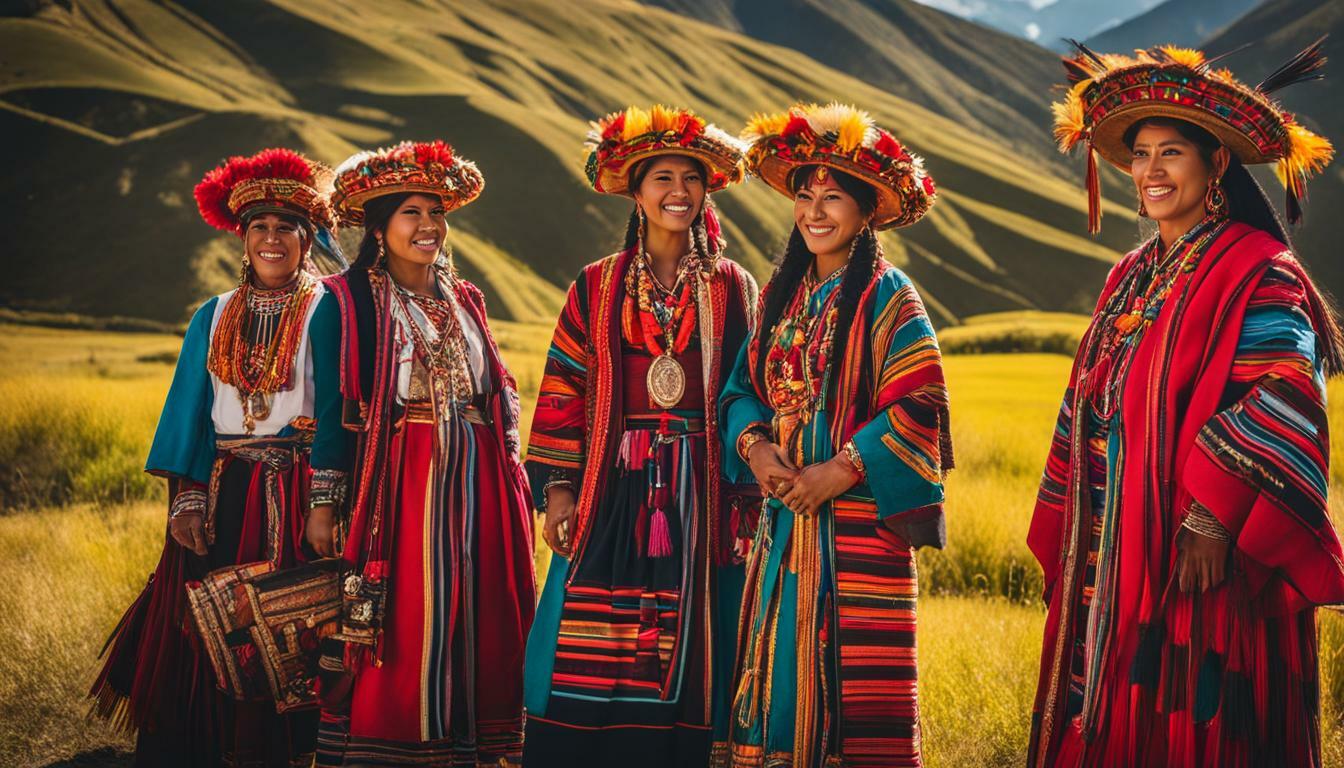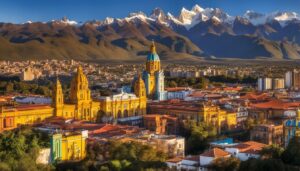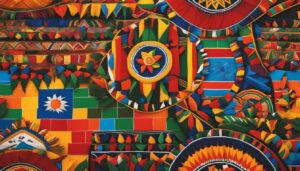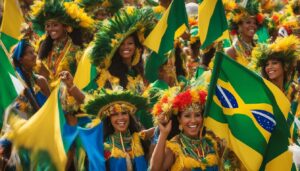Peru is a multilingual country with diverse languages spoken throughout its regions. The official languages in Peru are Spanish, Quechua, and Aymara. Spanish is the dominant language, spoken by approximately 94.4% of the population. Quechua and Aymara have co-official status and are spoken by 11.1% and 1.4% of the population, respectively.
In addition to these languages, there are over 80 indigenous languages and dialects spoken in Peru. These languages are particularly prevalent in rural areas and the Amazon region. Some examples include Jaqaru, Kawki, Urarina, and Iquito. The linguistic diversity in Peru reflects the rich cultural heritage and the influence of indigenous communities.
Key Takeaways:
- Spanish is the official language of Peru, spoken by the majority of the population.
- Quechua and Aymara have co-official status and are also widely spoken.
- Peru is home to over 80 indigenous languages and dialects, showcasing its linguistic diversity.
- The prevalence of indigenous languages is higher in rural areas and the Amazon region.
- The diverse languages spoken in Peru reflect the country’s rich cultural heritage.
Official Languages in Peru
The official language of Peru is Spanish, which plays a central role in communication and daily life. As the dominant language, it is spoken by approximately 94.4% of the population in the country. Spanish has strong historical and cultural significance in Peru, as it was introduced during the Spanish colonization in the 16th century and has been widely adopted ever since.
In addition to Spanish, Peru recognizes Quechua and Aymara as co-official languages. Quechua, spoken by around 11.1% of the population, holds deep ancestral roots as it was the language of the Inca Empire. Aymara, spoken by approximately 1.4% of the population, is predominantly spoken in the southern highlands and altiplano regions of Peru.
Peru’s commitment to recognizing and preserving these indigenous languages demonstrates the country’s respect for its diverse cultural heritage. Through their official status, Quechua and Aymara contribute to the preservation of indigenous identity and the promotion of linguistic diversity in Peru.
| Language | Speakers |
|---|---|
| Spanish | 94.4% |
| Quechua | 11.1% |
| Aymara | 1.4% |
| Other Indigenous Languages and Dialects | Varied |
Besides the official languages, Peru boasts a rich tapestry of over 80 indigenous languages and dialects. These languages, such as Jaqaru, Kawki, Urarina, and Iquito, are predominantly spoken in rural areas and the Amazon region, reflecting the cultural diversity and heritage of different indigenous communities in Peru.
Peru’s linguistic landscape is a testament to the country’s commitment to preserving its cultural heritage and embracing its multicultural identity. The official languages, Spanish, Quechua, and Aymara, along with the myriad of indigenous languages and dialects, contribute to the vibrant tapestry of Peru’s linguistic diversity.
Indigenous Languages in Peru
In addition to Spanish, Peru is home to several indigenous languages, including Quechua and Aymara. These languages play a significant role in the country’s cultural identity. Quechua, with 11.1% of the population speaking it, holds co-official status in many regions of Peru. It is believed to have originated from the ancient Inca civilization and is still widely spoken in the Andean highlands.
Aymara, spoken by 1.4% of the population, is another indigenous language recognized as co-official in certain areas of Peru. It is primarily spoken by the Aymara people who reside in the southern highlands and the bordering regions of Bolivia and Chile. Aymara has a rich oral tradition and is deeply intertwined with the cultural heritage of these communities.
Peru’s linguistic diversity extends beyond Quechua and Aymara, with over 80 indigenous languages and dialects spoken throughout the country. These languages are predominantly found in rural areas and the Amazon region, where indigenous communities have preserved their ancestral languages for generations.
Some of the lesser-known indigenous languages in Peru include Jaqaru, Kawki, Urarina, and Iquito, among others. These languages are integral to the cultural fabric of their respective communities and contribute to the overall linguistic richness of Peru. While Spanish remains the dominant language in the country, efforts are being made to promote and preserve these indigenous languages, recognizing their importance in maintaining cultural heritage and fostering community cohesion.
| Language | Official Status | Percentage of Population |
|---|---|---|
| Quechua | Co-official in certain regions | 11.1% |
| Aymara | Co-official in certain regions | 1.4% |
| Other Indigenous Languages | Not co-official | Varies |
The linguistic diversity in Peru is a testament to the country’s rich cultural tapestry and the resilience of its indigenous populations. It is through the preservation and celebration of these indigenous languages that Peru continues to honor its heritage and foster a sense of unity among its diverse communities.
Spanish as the Dominant Language
Spanish is the most widely spoken language in Peru, making it a prominent feature of the country’s cultural landscape. With approximately 94.4% of the population speaking Spanish, it holds an essential role in communication, education, and daily life throughout the nation.
This dominance of the Spanish language can be attributed to Peru’s complex history, which includes Spanish colonization and the subsequent influence of Spanish culture. It has become deeply ingrained in Peru’s society, shaping not only the way people communicate but also their cultural practices and customs.
As I wandered the vibrant streets of Lima, I couldn’t help but notice the ubiquity of Spanish. From the bustling markets to the quaint cafes, Spanish was the language that permeated every corner of the city.
Furthermore, Spanish serves as a common language for trade and commerce, allowing Peruvians to connect with Spanish-speaking countries in South America and beyond. It opens doors to economic opportunities and facilitates interactions with neighboring nations.
Preserving Linguistic Diversity
While Spanish may hold dominance in Peru, it is important to recognize and celebrate the linguistic diversity present in the country. Quechua and Aymara, two indigenous languages, hold co-official status in certain regions of Peru, with approximately 11.1% and 1.4% of the population speaking these languages, respectively.
In addition to Quechua and Aymara, Peru is home to over 80 indigenous languages and dialects. These languages, such as Jaqaru, Kawki, Urarina, and Iquito, are predominantly spoken in rural areas and the Amazon region, where indigenous communities thrive and uphold their rich cultural heritage.
| Language | Number of Speakers |
|---|---|
| Spanish | Approximately 94.4% |
| Quechua | Approximately 11.1% |
| Aymara | Approximately 1.4% |
| Other Indigenous Languages and Dialects | Varies |
The linguistic tapestry of Peru reveals the country’s commitment to preserving and promoting its diverse cultural heritage. It serves as a testament to the strength and resilience of indigenous communities, showcasing their languages as integral parts of Peru’s identity.
Other Indigenous Languages and Dialects
Apart from Quechua and Aymara, Peru boasts a diverse array of indigenous languages and dialects. With over 80 languages spoken in the country, Peru showcases a remarkable linguistic richness that reflects its cultural heritage and indigenous community influences.
Some of the lesser-known indigenous languages spoken in Peru include Jaqaru, Kawki, Urarina, and Iquito, to name just a few. Each of these languages carries with it a unique history and serves as a testament to the cultural diversity found within the country.
To illustrate the linguistic diversity in Peru, indigenous languages can be broadly categorized into several language families, such as Quechuan, Aymaran, Amazonian, and Uru-Chipaya. These linguistic groups further branch out into various dialects, each with its own nuances and characteristics.
| Language Family | Languages and Dialects |
|---|---|
| Quechuan | Quechua, Chanka, Huallaga Quechua |
| Aymaran | Aymara, Jaqaru, Uru |
| Amazonian | Shipibo-Konibo, Ashaninka, Yanesha |
| Uru-Chipaya | Uru, Chipaya |
These indigenous languages and dialects are predominantly spoken in rural areas and the Amazon region of Peru, where indigenous communities continue to preserve their ancestral languages and cultural traditions.
“The linguistic diversity in Peru is a testament to the country’s rich cultural tapestry, showcasing the invaluable contributions and resilience of its indigenous communities.” – Language expert
In Conclusion
The linguistic landscape of Peru is as diverse as its geography and people. With Spanish, Quechua, and Aymara as official languages, and numerous indigenous languages and dialects spoken throughout the country, Peru stands as a linguistic treasure trove that reflects the multicultural heritage of its population.
Language Diversity in Rural and Amazon Regions
The rural areas and Amazon region of Peru are known for their linguistic diversity, with numerous indigenous languages being spoken there. This diversity reflects the cultural richness and heritage of the indigenous communities in these regions. In addition to the official languages of Spanish, Quechua, and Aymara, there are over 80 indigenous languages and dialects spoken in Peru.
Indigenous Languages in Rural Areas
Many indigenous languages thrive in the rural areas of Peru, where indigenous communities have preserved their linguistic traditions and heritage. These languages include Jaqaru, Kawki, Urarina, and Iquito, among others. Each language represents a unique cultural identity and serves as a testament to the resilience and vitality of indigenous cultures.
The linguistic diversity in rural areas provides a fascinating insight into the depth of Peru’s indigenous heritage. It is a testament to the country’s commitment to preserving cultural diversity and ensuring the inclusion of indigenous languages in national discourse.
Indigenous Languages in the Amazon Region
The Amazon region of Peru is home to an astonishing array of indigenous languages. The linguistic diversity in this area is unparalleled, with communities speaking languages like Shipibo-Konibo, Ashaninka, and Awajún, to name just a few. These languages are not only a means of communication but also a source of cultural pride and identity for the indigenous peoples of the Amazon.
The preservation and revitalization of indigenous languages in the Amazon region are of utmost importance. Efforts are being made to promote bilingual education, language documentation, and cultural exchange programs to ensure the continued existence and vitality of these languages.
| Indigenous Languages | Region |
|---|---|
| Jaqaru | Puno |
| Kawki | Ancash |
| Urarina | Loreto |
| Iquito | Loreto |
Indigenous languages in Peru are not just a means of communication; they are a testament to the rich cultural history and heritage of the country. The linguistic diversity in rural areas and the Amazon region highlights the importance of preserving and promoting these languages to ensure the inclusivity and cultural recognition of indigenous communities in Peru.
Conclusion
The diverse linguistic landscape of Peru reflects its rich cultural heritage and the integral role that language plays in shaping the country’s identity. With Spanish as the dominant language, spoken by approximately 94.4% of the population, it is not only the official language but also a prominent aspect of Peruvian culture and society.
Additionally, Quechua and Aymara hold co-official status and are spoken by 11.1% and 1.4% of the population respectively, showcasing the importance of indigenous languages in Peru. Beyond these official languages, Peru is home to over 80 indigenous languages and dialects, including Jaqaru, Kawki, Urarina, and Iquito, among others.
These diverse languages are primarily spoken in rural areas and the Amazon region, where they play a significant role in preserving cultural heritage and connecting indigenous communities. The linguistic diversity in Peru not only reflects the ancestral roots of its people but also showcases the country’s commitment to honoring and preserving its indigenous traditions.
In conclusion, Peru’s language landscape is a testament to its rich cultural tapestry, highlighting the importance of linguistic diversity in shaping national identity. From Spanish to Quechua, Aymara, and numerous indigenous languages and dialects, Peru is a linguistic treasure trove that embraces the myriad voices and heritage of its people.
FAQ
What language do they speak in Peru?
The official languages of Peru are Spanish, Quechua, and Aymara. Spanish is the dominant language spoken by about 94.4% of the population.
What are the official languages in Peru?
The official languages in Peru are Spanish, Quechua, and Aymara.
How widely spoken is Spanish in Peru?
Spanish is the most commonly spoken language in Peru, with about 94.4% of the population speaking it.
What are the indigenous languages spoken in Peru?
In addition to Spanish, Quechua and Aymara have co-official status in certain regions of Peru. There are also over 80 indigenous languages and dialects spoken in the country, particularly in rural areas and the Amazon region.
What are some examples of indigenous languages in Peru?
Some examples of indigenous languages spoken in Peru include Jaqaru, Kawki, Urarina, and Iquito, among many others.
Where are indigenous languages most prevalent in Peru?
Indigenous languages are most prevalent in rural areas and the Amazon region of Peru.



